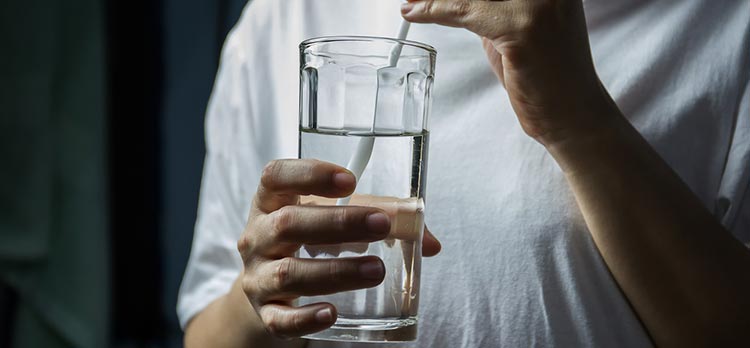Raw Water: A Dangerous Fad, Not the Solution

A new national survey shows that approximately 200 million Americans worry about what may be in their tap water. This isn't surprising, given the recent water contamination in Flint, MI, Fresno, CA and Chicago, IL. It is disturbing that 56% of the US population is wondering if the water coming into their homes water they use to cook food, bathe their children and water their lawns with, contains lead, carcinogens, micro-plastics, or worse.
These water contamination incidents, while not widespread, present real health hazards, and raise urgent questions about the safety and purity of our nation's water infrastructure. But there's a secondary consequence that is the direct result of America's distrust of tap water. It's dubbed the "Raw Water Phenomenon", and it is raising alarm.
The Raw Water Phenomenon emerged out of Silicon Valley and has begun to draw buzz across the nation. (Including an excellent Stephen Colbert segment on Live Water's marketing efforts.) Raw water is marketed as "unfiltered, untreated, unsterilized spring water" by a company called Live Water.
Raw water proponents are worried about pollutants and even chlorine in tap water and seek to "consume water as nature intended." This is a terrible and dangerous idea. According to the CDC, untreated water can spread bacteria and diseases, including cholera, E. coli bacteria, viruses, parasites, carcinogenic compounds, and animal feces!
While some Americans are being trendy by consuming the official "raw water," perhaps lured in by the beautiful bottle it is being sold in, others stick to traditional bottled water to feel safe. Plastic water bottles bring a slew of issues of their own including environmental pollution, questionable water quality and cost. The same survey, commissioned by water advocacy brand Bluewater, found that nearly 70 percent of Americans drink water from plastic bottles on a weekly basis regardless of the quality, taste or purity of their tap water and 33 percent drink five or more bottles per week.
"Americans understand their water supply may contain nasty carcinogens like lead and plastic, and are taking action to control their daily intake, but the way they're going about it is largely the wrong solution," said Bengt Rittri, environmental entrepreneur and founder of Bluewater. "Environmentally destructive plastic water bottles and the newest crazes like raw water are not sensible solutions. They are at the very least unsustainable, and often downright dangerous."
So what are the alternatives?
For Americans wondering how they can acquire clean water, there are much better options for healthy hydration. First, test your well and/or learn what has been found in your tap water. The Environmental Working Group (EWG) has a national "tap water database" that reveals which contaminants are found in every zip code's tap water supply.
Second, consider a good water filtration system. These systems are the best guarantee of clean, sweet smelling and pure drinking water. The gold standard of water filtration, reverse osmosis water purifiers, remove 99.9% of all contaminants. They are backed by the EWG as the "most effective water filtration system."
Less expensive carbon filters and generally available filtration devices vary in effectiveness, but most filters are better than nothing. Plus, using filtered tap water instead of single-use bottled water makes a genuine impact on the plastic disposal problem.
Bluewater has donated two of its reverse osmosis water purifiers to a local community soup kitchen in Flint, MI, as a kind of on-the-ground experiment. Rittri explains, "The purifiers in Flint, MI are an example of the potential of water filtration systems. Each day, we generated 1,248 gallons of clean water, replacing 4,726 one-liter plastic water bottles, which were used by residents throughout the crisis."
"Society has a responsibility to make access to safe, sanitary, clean water a basic human right while reducing plastic pollution." he continues. "We just need to take the first steps."
So reject "raw water" - which like raw eggs, raw hamburger and raw sewage is NOT a safe choice, and get smart about your water supply. Invest in filtration or purification options, and think twice about every single-use plastic bottle you or your family uses. Switch to reusable metal canister type bottles for portable water for picnics, outings, and the playground. You'll play it safe, and help the environment every single day.
Article Source: http://inc-asean.com/the-inc-life/raw-water-dangerous-fad-not-solution/
Image Source: http://duvna0llx4199.cloudfront.net/wp-content/uploads/2018/01/18164345/rawwater_750x348.jpg
VOCABULARY WORDS:
1. Fad (n.) ~ an intense and widely shared enthusiasm for something, especially one that is short-lived and without basis in the object's qualities a craze
2. Dub (v.) ~ give an unofficial name or nickname to (someone or something)
3. Proponent (n.) ~ a person who advocates a theory, proposal, or project
4. Lure (v.) ~ tempt (a person or an animal) to do something or to go somewhere, especially by offering some form of reward
5. Sensible (adj.) ~ (of a statement or course of action) chosen in accordance with wisdom or prudence likely to be of benefit
6. Canister (n.) ~ a round or cylindrical container, typically one made of metal, used for storing such things as food, chemicals, or rolls of film
QUESTIONS FOR DISCUSSION:
1. According to the article, what is 'raw water'? What are the possible dangers of drinking it?
2. In your country, is tap water safe for consumption? Where do you usually get your drinking water?
3. What do you think are the better alternatives for tap water and bottled water?
4. Do you think that having a water filtration system at home is worth the cost? Discuss your answer.